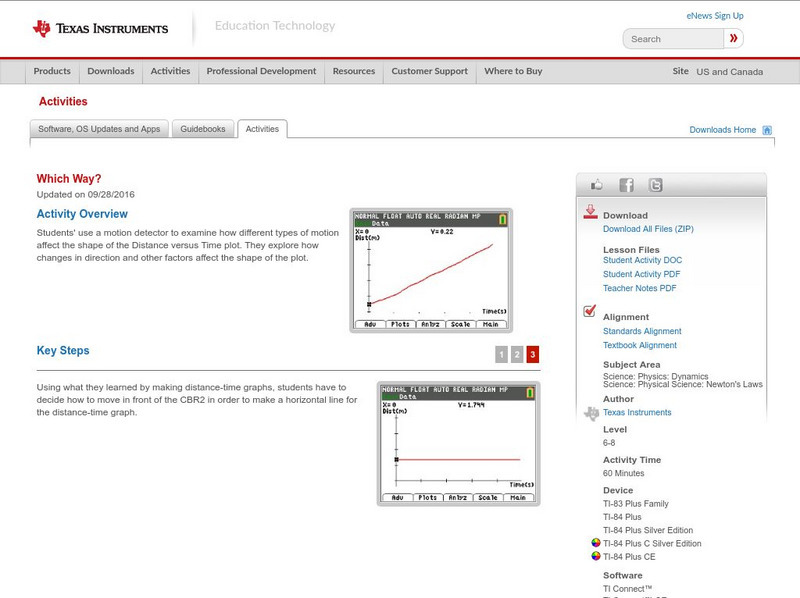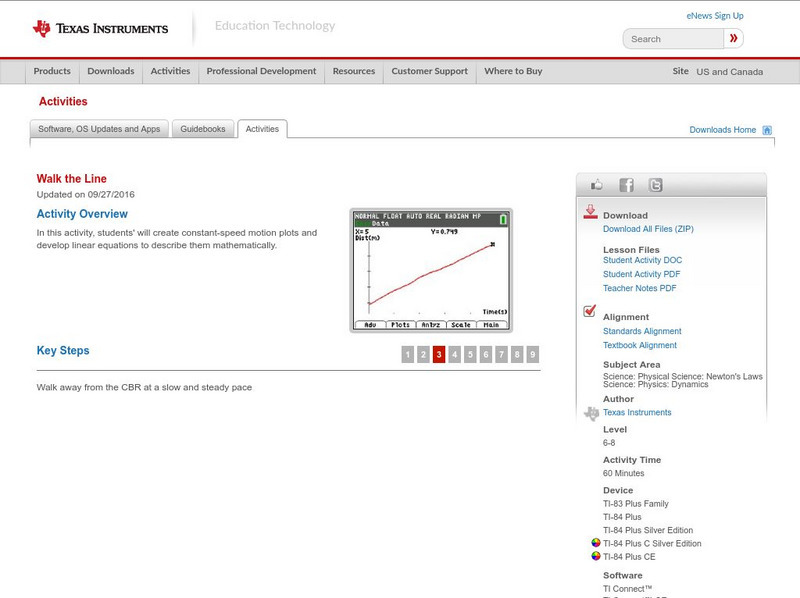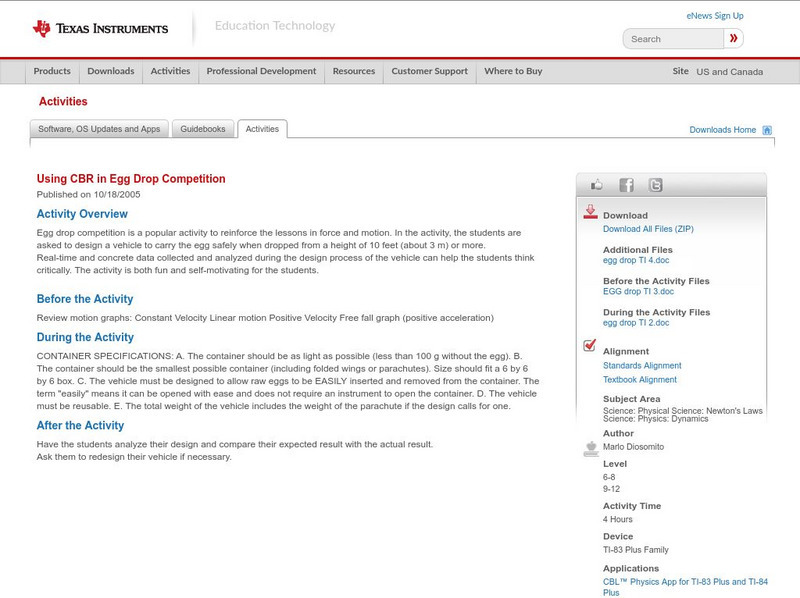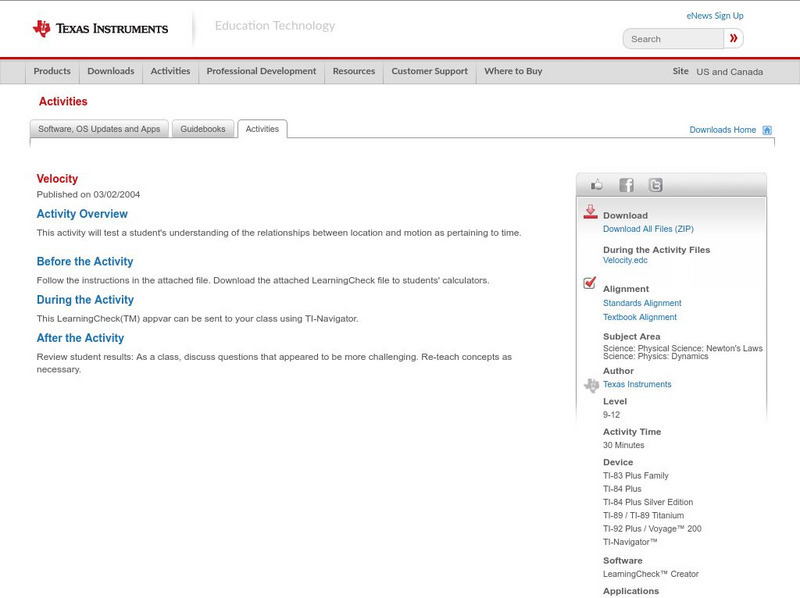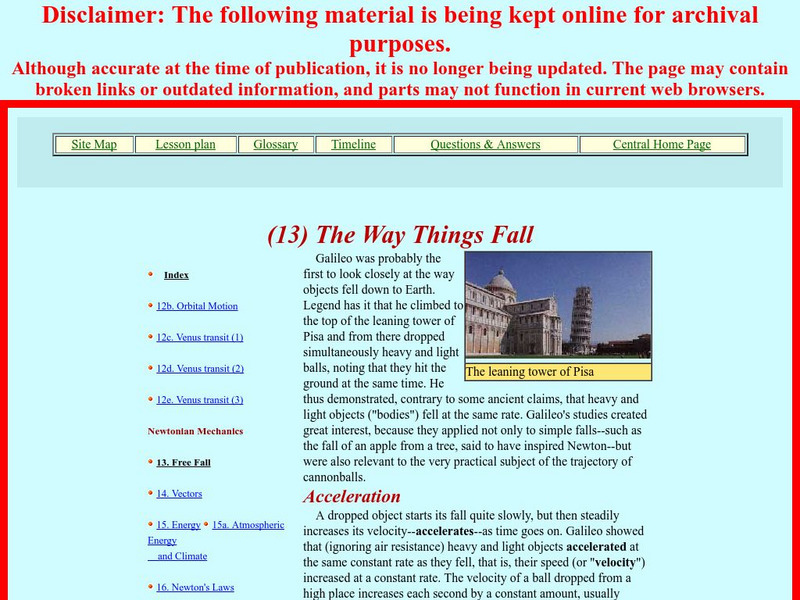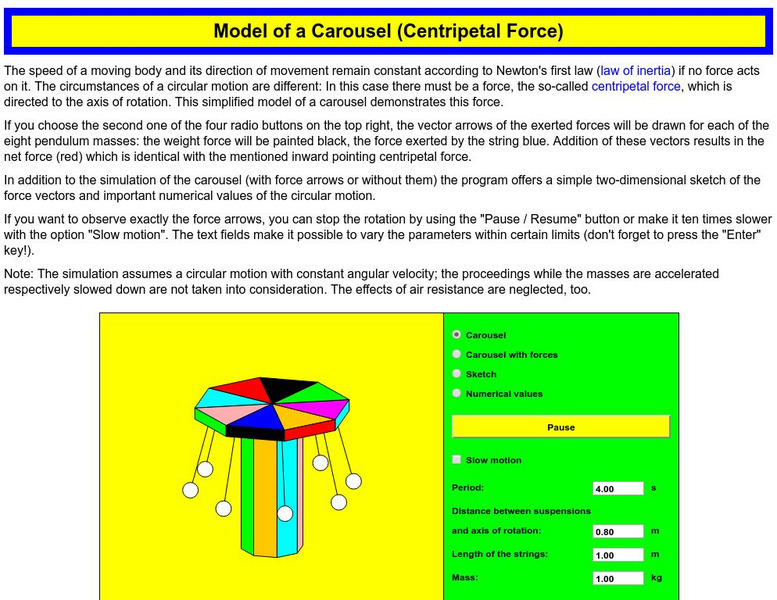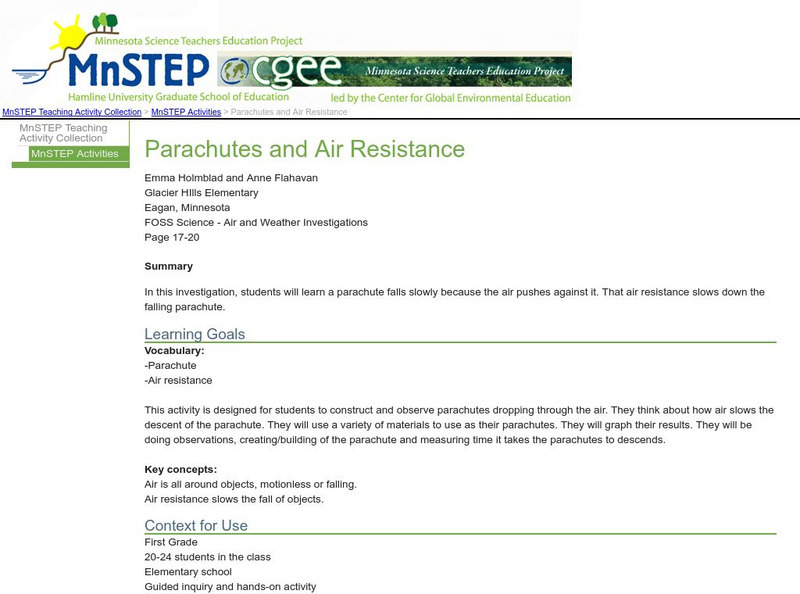Texas Instruments
Texas Instruments: Which Way?
Students' use a motion detector to examine how different types of motion affect the shape of the distance versus time plot. They explore how changes in direction and other factors affect the shape of the plot.
Massachusetts Institute of Technology
Mit: Open Course Ware: Angular Momentum and Conservation
Students explore angular momentum and conservation. Some topics examined in the activities are angular momentum, torque, and conservation. The resource consists of video clips, lecture notes, practice problems, and exam questions....
Texas Instruments
Texas Instruments: Slow Down: Speed Up
In this activity, students' will use a motion detector to observe the effect of speeding up, slowing down, and moving at a constant rate on a Distance versus Time plot.
Texas Instruments
Texas Instruments: Walk the Line
In this activity, students will create constant-speed motion plots and develop linear equations to describe them mathematically.
Texas Instruments
Texas Instruments: Using Cbr in Egg Drop Competition
Egg drop competition is a popular activity to reinforce the lessons in force and motion. In the activity, the students are asked to design a vehicle to carry the egg safely when dropped from a height of 10 feet (about 3 m) or more....
Texas Instruments
Texas Instruments: Falling Objects
In this activity, Students can use a Motion Detector to measure distance and velocity.
Texas Instruments
Texas Instruments: How Can a Clock Part Measure Gravity?
In this activity students will learn how to make a simple pendulum. Students' will use a motion detector to measure the period of a pendulum and calculate its acceleration.They will also understand the effect that gravity has on the...
Texas Instruments
Texas Instruments: Velocity
This activity will test a student's understanding of the relationships between location and motion as pertaining to time.
Texas Instruments
Texas Instruments: What's Your Speed?
In this activity, students' will use a motion detector to determine what effect the speed at which a person moves has on the appearance of the distance versus time plot.
NASA
Nasa: The Way Things Fall
This site from NASA compares free falling motion to falling with air resistance. Discusses Galileo's experiment. Explains why we believe all objects free fall with the same acceleration.
Physics Central
Physics Central: Physics by the Fire: Match Stick Rocket
Match stick rockets makes a great demonstrations to show students Newton's third law. By covering a match with tin foil, students can see the reaction thrust as the molecules escaping the matchstick are propelled into the air. Lesson...
Walter Fendt
Walter Fendt: Model of a Carousel: Centripetal Force
This resource features an applet that models the motion of a carousel ride at an amusement park to demonstrate centripetal force. The motion parameters can be modified and seen in the animation.
Physics Classroom
The Physics Classroom: The Car and the Wall
The Physics Classroom uses an animation of a car crash to lead its discussion on the law of inertia.
Science Education Resource Center at Carleton College
Serc: Parachutes and Air Resistance
By using different materials students construct a parachute to show how air resistance slows down its fall in this lesson.
OpenStax
Open Stax: Applications of Statics, Including Problem Solving Strategies
From a chapter on Statics and Torque in a Physics textbook. This section of the chapter discusses how statics can be applied in the real world, and strategies for solving statics problems. Includes a question, two exercises, and a...
Science Buddies
Science Buddies: Teaching Engineering Design With an Egg Drop
Learners build a device to protect an egg and prevent it from breaking when dropped.
Scholastic
Scholastic: Study Jams! Science: Force and Motion: Newton's First Law: Inertia
A video and a short multiple-choice quiz on the meaning of inertia.
Sophia Learning
Sophia: Improperly Defining a System
This presentation explains why a poorly defined system can lead to incorrect answers in physics problems.
Scholastic
Scholastic: Study Jams! Science: Forces and Motion: Acceleration
A video and a short quiz on acceleration.
Texas Education Agency
Texas Gateway: 4.1 Development of Force Concept
By the end of this section, you will be able to understand the definition of force.
Texas Education Agency
Texas Gateway: 4.8 Extended Topic: The Four Basic Forces: An Introduction
By the end of this section, you will be able to understand the four basic forces that underlie the processes in nature: gravitational, electromagnetic, weak nuclear, strong nuclear forces.
NASA
Nasa: Beginner's Guide to Aerodynamics
This site from NASA uses a colorful graphic to illustrate why objects reach terminal velocity. Provides equation for the terminal velocity of an object. Graphic is accompanied by a simple explanation.
Physics World
Physics World: Contextual Physics in Ocean Park
After downloading the "Motion Video Analysis" software, users can collect data about moving object's position from digital movie clips. This collection of data will allow them to plot motion graphs and draw conclusions about physics in...
University of Maryland
University of Marylad: Computer Tutorials in Physics: Air Resistance
This site has a discussion of a college physics project in which the motion of an object under the influence of air resistance was modeled and studied. Procedure and modeling software are described and the results and the findings are...


